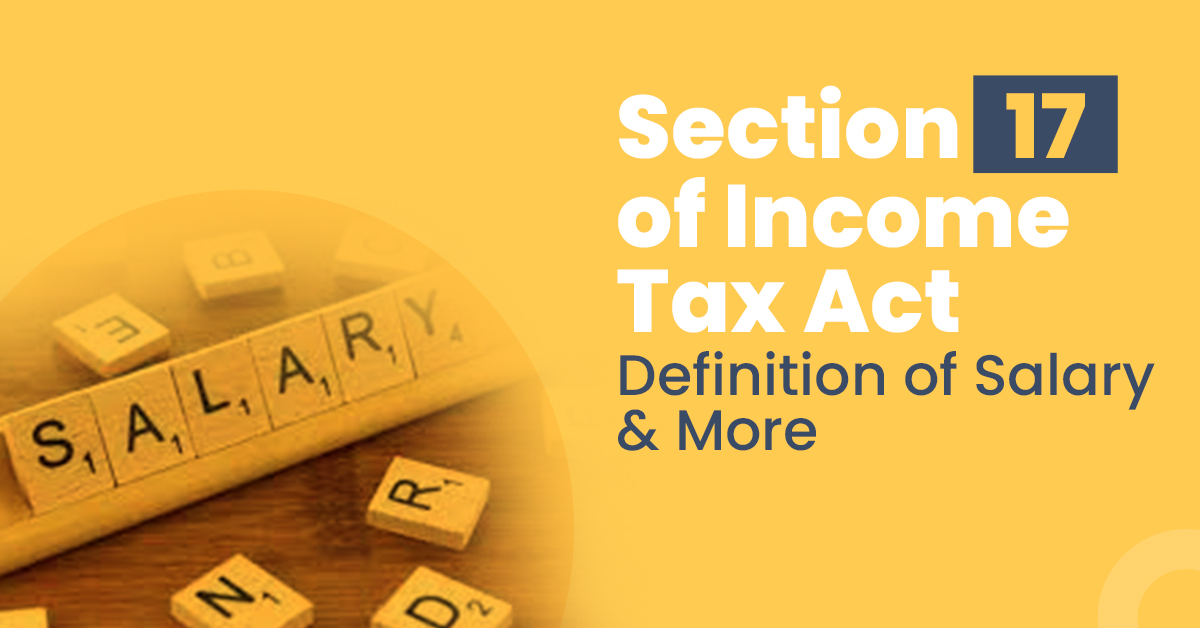Section 17 of the Income Tax Act – Definition Of Salary and More


More than 52 Crore people in India were employed in the financial year 2022, as per the statistics released by the online market research platform, Statista. This roughly accounts for more than 35% of the country’s population! Therefore, it is important for us, as employees, to know the benefits that we are liable to receive from our employers defined for tax treatment.
In this article, we discuss Section 17 of the Income Tax Act in detail. Section 17 defines the three benefits provided to employees by employers, namely, the salary, perquisites, and profits in lieu of salary. Let us begin!
How many Provisions are included Under Section 17?
Section 17 of the Income Tax Act includes three provisions and comprehensively describes the definition of these components of employee benefits provided by an employer. They are as follows:
- Section 17 (1)
This provision of Section 17 defines the main component of the employee benefit – salary.
Meaning of Salary as Per Section 17 (1)
As per the provision Section 17 (1), the term ‘salary’ refers to the monetary remuneration received by an employee from their employer. This could be provided as –
- Wage – A sum of money payable by the employer as per the terms of the employment contract in return for the services rendered by the employee. You might find ‘wage’ under the name remuneration, basic pay, or salary in your salary slips. This also includes payment made by the employer towards paid leave. Also, any amount due from the employer for the work done by the employee is also termed as ‘wage’.
- Advance salary – Any amount which has been paid by the employer before the employee has rendered their services to the organisation is termed as ‘advance salary’. It is important to note that a loan taken from the employer does not qualify as an advance salary.
- Fees – Any amount paid by the employer in return for the services received from the employee is called ‘Fees’.
- Commission – A fixed percentage paid to the employee on completion of certain tasks is called ‘commission’ and is included under the head ‘Salary.’ For instance, a certain fixed percentage is paid on the achievement of a certain sales target.
- Annuity / Pension – The sum of money paid by the current employer on the attainment of the retirement age by the employee is called an ‘Annuity’.
Gratuity – A lump sum paid by the employer voluntarily as a token of appreciation for the services rendered by the employee. This is generally provided after the completion of a certain number of years of service. - Leave encashment – Employers may also provide a monetary benefit in return for the leave balance unused by the employee. This is generally paid as a percentage of the basic pay of salary. This can be provided either during the term of employment or its termination. Some employers provide leave encashment on or after the attainment of the retirement age.
- Contribution towards NPS: The contribution made by the employer towards the National Pension Scheme (NPS) is also considered a part of the ‘salary’ of the employee.
If an employee has chosen to receive an additional contribution to their provident fund to a limit that attracts tax, the same amount should be treated as salary under Section 17 (1) of the Income Tax Act.
It is important to note here, that for the monetary remuneration to be termed ‘salary,’ there must exist an employer-employee relationship.
Allowed deductions from Salary Income
Section 16 of the Income Tax Act allows for the following as deductions from salary –
- Employment/professional tax levied by a state government
- Entertainment allowance which is available to government employees to an extent of ₹5,000 or 20% of their salary, whichever is lower.
- Standard deduction of up to ₹50,000.
- Section 17 (2)
Section 17 (2) of the Income Tax Act clarifies the terms ‘perquisites’ receivable by an employee from their employer. There are two kinds of perquisites – monetary and non-monetary.
Enlisted are the different employee benefits which are termed as ‘perquisites’ under the Income Tax Act –
- Expenditure provided by the employer for employees’ travel
- Value of rent-free accommodation provided by an employer
- Value of concessional rent provided by an employer
- Employer’s contribution to the provident fund
- Value of Gratuity
- Superannuation benefits provided by the employer
- Employer’s contribution to deposit-linked insurance schemes
- Insurance premiums paid by the employer for the employee
- Value of any benefit provided at a concessional rate by the employer
- The value of sweat equity shares or any other security transferred by an employer to their employee for free or at a concessional rate
- Value of free domestic help provided by the employer at the employee’s residence
- Free water, gas, electricity, or internet connection provided by the employer
- Value of food coupons
- Free or reimbursement of educational facilities for the employees’ children worth more than ₹1,000
- Any other expense that is borne by the employer in place of the employee.
Perquisites also include the value of any other benefit provided to the following by the employer for free or at a concessional rate –
- To a director of the company
- To an employee who maintains a substantial interest in the company
Perquisites Exempt From Tax Treatment
The following perquisites are exempted from tax, that is, they attract no tax –
- Telephone expenses are borne by the employer for the employee
- Concessional or free loans provided by the employer for medical treatment of a disease specified in rule 3 A of the Income Tax Act or if the loan amount is not more than ₹20,000
- The rent-free official residence provided to a Judge of a High Court or the Supreme Court or a Union Minister, Parliament Official, or the Leader of the Opposition in the Parliament
- Perquisites permitted by the Government of India to a city outside India for rendering services outside the geographical boundaries of the country.
- Section 17 (3)
This provision of Section 17 defines the ‘profits in lieu of salary’. These profits refer to all the other additional benefits provided by an employer instead of paying them as the basic salary. These are generally paid out in monetary form and it is often difficult to differentiate between these and those employee benefits. Thus, the following list of benefits which qualify as ‘profits in lieu of salary’ comes in useful –
- The compensation received by an employee from an employer at the time of termination of their employment contract or due to modifications in the terms of employment
- Amount of money payable before beginning or after the termination of employment
- Payments made under Keyman Insurance Policy
- Employer contributions made towards unrecognised superannuation or provident fund
- Any amount paid by the employer voluntarily
- Payments made by the employer under a legal obligation.
Frequently Asked Questions
When shall the salary be chargeable to tax?
According to Section 15 of the Income Tax Act, the salary shall become chargeable to tax either on a receipt basis or a due basis whichever happens first.
Under which head does accrued salary fall?
Accrued salary refers to the salary that has been due to the employer but has not yet been received by the employee. It shall be categorised under the head ‘salary’ as per Section 17 (1) of the Income Tax Act.
Who is responsible for paying taxes on perquisites?
Perquisites attract taxation at the rate of 30% and are chargeable at the hands of the organisation providing them.
Are there any exemptions under Section 17 of the Income Tax Act?
Yes, income such as reimbursement of medical bills by the employer, allowance travelled for official travel, etc., do not fall under the taxable income heads under Section 17 of the Income Tax Act.
What is an unrecognised provident fund?
A provident fund that has not been approved by the Commissioner of Income Tax under the Employees’ Provident Fund and Miscellaneous Fund is an unrecognised provident fund.




